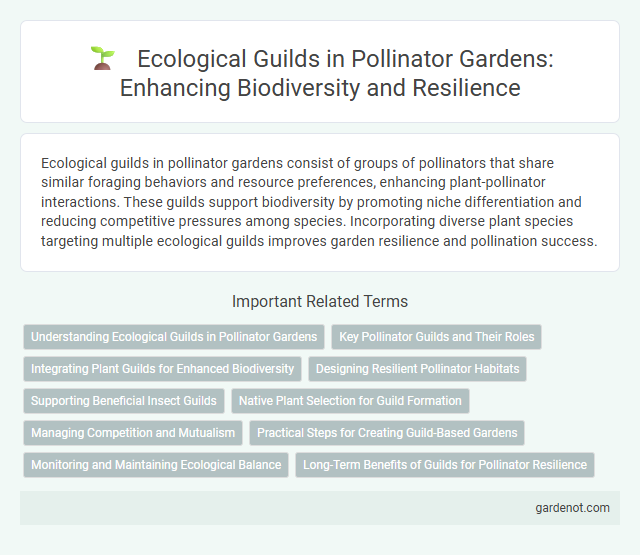Ecological guilds in pollinator gardens consist of groups of pollinators that share similar foraging behaviors and resource preferences, enhancing plant-pollinator interactions. These guilds support biodiversity by promoting niche differentiation and reducing competitive pressures among species. Incorporating diverse plant species targeting multiple ecological guilds improves garden resilience and pollination success.
Understanding Ecological Guilds in Pollinator Gardens
Ecological guilds in pollinator gardens consist of groups of species that exploit the same resources or perform similar ecological roles, such as pollination of specific plant types. Understanding these guilds helps optimize garden design by promoting biodiversity and enhancing pollination efficiency through complementary interactions among bees, butterflies, hummingbirds, and other pollinators. Incorporating diverse flowering plants tailored to the needs of multiple ecological guilds supports resilient and sustainable ecosystems.
Key Pollinator Guilds and Their Roles
Key pollinator guilds in a pollinator garden include bees, butterflies, moths, hummingbirds, and beetles, each playing a unique role in pollination dynamics. Bees, especially native solitary and social species, are primary pollinators responsible for efficient pollen transfer, while butterflies and moths contribute to cross-pollination through their foraging behavior. Hummingbirds aid in pollination of tubular flowers, and beetles often pollinate flowers with strong scents and sturdy structures, supporting overall biodiversity and ecosystem resilience.
Integrating Plant Guilds for Enhanced Biodiversity
Integrating plant guilds within a pollinator garden enhances ecological resilience by fostering diverse habitats that support various pollinator species such as bees, butterflies, and hummingbirds. Plant guilds--comprising flowering plants, host plants, nectar sources, and shelter species--create synergistic relationships that sustain pollinator life cycles and improve ecosystem services like pollination efficiency. This strategic biodiversity not only boosts garden productivity but also promotes long-term environmental stability.
Designing Resilient Pollinator Habitats
Designing resilient pollinator habitats involves creating ecological guilds that support diverse pollinator species by integrating native flowering plants, nesting sites, and seasonal bloom continuity. Emphasizing plant-pollinator interactions within these guilds enhances habitat stability and promotes ecosystem services such as pollination efficiency and biodiversity conservation. Structured habitat complexity and resource availability increase resilience against environmental stressors and climate variability.
Supporting Beneficial Insect Guilds
Supporting beneficial insect guilds in a pollinator garden enhances ecological balance by promoting diverse populations of predatory and parasitic insects that naturally control pests. Establishing a variety of native flowering plants provides critical resources such as nectar, pollen, and habitat, which sustain these beneficial insects throughout their life cycles. This guild-based approach fosters resilient ecosystems, improves pollination services, and reduces the need for chemical pest control.
Native Plant Selection for Guild Formation
Native plant selection is critical for ecological guild formation in pollinator gardens, as these plants provide essential resources like nectar, pollen, and habitat that coevolved with local pollinators. Targeting a diverse mix of native species--such as milkweed for monarch butterflies and goldenrod for native bees--supports a wide range of pollinators by creating interconnected food webs and microhabitats. Incorporating native plants enhances ecological resilience and promotes sustainable pollination services within the garden ecosystem.
Managing Competition and Mutualism
Managing competition and mutualism within a pollinator garden's ecological guild enhances biodiversity by balancing resource availability among native pollinators like bees, butterflies, and hummingbirds. Strategic planting of diverse flowering species with staggered bloom times reduces direct competition and fosters mutualistic relationships, improving pollination efficiency and plant reproduction. Understanding these interactions supports ecosystem resilience and promotes sustainable garden health.
Practical Steps for Creating Guild-Based Gardens
Designing a pollinator garden using ecological guild principles involves grouping plants that support each other and attract diverse pollinator species. Incorporate flowering plants with staggered bloom times, native shrubs for shelter, and host plants essential for butterfly larvae to ensure continuous resources throughout the seasons. Enhancing soil health with organic mulch and minimizing pesticide use maximizes habitat quality and supports a resilient pollinator community.
Monitoring and Maintaining Ecological Balance
Monitoring pollinator populations and plant diversity within a pollinator garden supports the maintenance of an ecological guild by ensuring the survival of key species like bees, butterflies, and native flowering plants. Maintaining ecological balance involves regularly assessing habitat quality, controlling invasive species, and providing continuous floral resources to sustain pollinator health. Data-driven management practices enhance ecosystem resilience and promote effective pollination services essential for biodiversity conservation.
Long-Term Benefits of Guilds for Pollinator Resilience
Ecological guilds in pollinator gardens enhance long-term resilience by supporting diverse species with complementary roles in pollination and habitat use. This biodiversity stabilizes pollination services against environmental fluctuations and mitigates the impact of pests and diseases. Over time, guild-based plantings promote ecosystem health, increase pollinator population stability, and improve crop yields through sustained pollination efficiency.
Ecological guild Infographic

 gardenot.com
gardenot.com